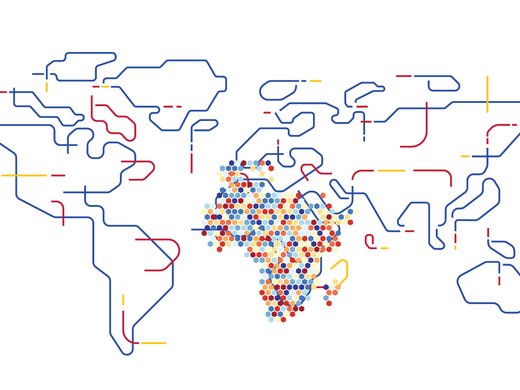Over the past two decades, messaging platforms, online marketplaces, app-based transportation and digital payment systems have become intertwined with our daily lives. This rapid digitalization is characterized by private corporate ownership and control. Ride-hailing platforms have fundamentally altered public transportation in many parts of the globe. Uber alone has 3.5 million drivers operating across 10,000 cities (Duncan 2022). Of the six social media platforms that claim one billion or more monthly active users, three are owned by Meta.1 The implications of this control surface from time to time. WhatsApp’s outage in 2021 affected millions of people around the world, including citizens in Argentina and Lebanon whose governments were relying on the service to provide public health updates on the COVID-19 outbreak (Cheng 2021). The mass reliance on Google Pay, Visa and Mastercard to make payments was exposed when these companies suspended services in Russia in the wake of the country’s war with Ukraine (Stognei and Fraser 2022).
Beyond platforms, the spectre of private ownership in digital infrastructure is also evident when we look to the cloud. Three private companies — Amazon, Microsoft and Google — control nearly two-thirds of the market share for cloud infrastructure (Vailshery 2024). Control over these systems often provides private entities with effective control over the data they generate. Insights derived from this data have significant potential for public good, but private companies often restrict — or outright deny — access to this data, citing various concerns such as privacy and business interests. Uber and Lyft, for example, have refused to share data with city authorities in the past (Austermuhle 2018). Given this influence, private ownership and control over digital infrastructures and the data within them are of significant concern.
In this context, the concept of digital public infrastructure (DPI) provides an alternative. India’s Unified Payments Interface is an example of DPI. It is a government-backed payment system that facilitates instant interbank, peer-to-peer and person-to-merchant transactions. While private firms and their apps can plug into the system, they must use open protocols for exchanging information and enabling payments, and adhere to the rules of the system set out by the Reserve Bank of India. The Unified Payments Interface has significantly broadened access to digital banking and has become the preferred mode of payment in India (Business Standard 2023), with more than 12 billion transactions recorded each month (TOI Tech Desk 2024). Its success has also seen India share the technology with other countries, including Australia, France, Saudi Arabia and Singapore.
Just as physical infrastructure was considered crucial to the movement of people and goods in the twentieth century, so too is digital infrastructure, such as identity and payment systems, for contemporary society.
DPI borrows lessons from nation-states’ experience of building physical infrastructure , such as roads and railways (Eaves 2023). Just as physical infrastructure was considered crucial to the movement of people and goods in the twentieth century, so too is digital infrastructure, such as identity and payment systems, for contemporary society. And just as governments have had a critical role to play in building and maintaining physical infrastructure, proponents of DPI argue that an active state is needed to ensure that a nation runs smoothly and citizens’ needs are met. Ethan Zuckerman (2020) described DPI as a crucial lever for civic engagement, with the potential to transform the state-citizen relationship by enabling more effective citizen-government interactions, promoting transparency and fostering citizen participation.
The exact nature of the state’s role in DPI is, however, a matter of debate. On one hand, the state’s position as a builder, procurer or facilitator of DPI impacts the reach and authority of institutional mechanisms and has implications around the accountability of DPI systems. If the state is the sole builder and provider of DPI solutions, there is greater scope for intervention on the part of citizens and institutions to mandate the utmost commitment to fairness. On the other hand, as a procurer or facilitator for DPI, the state might rely more on private entities, raising concerns about privacy, surveillance and the commodification of essential services. In certain circumstances, the actions of private entities may not be open to the scrutiny of public institutions, raising concerns about oversight and transparency. This debate around the role of the state takes on added significance with the evolution toward a “digital welfare state” (Gupta 2023), which has seen a shift in how welfare services are delivered, with an increasing reliance on digital platforms and tools.
Breaking private strongholds and revitalizing the role of the state in the digital realm are not the only drivers of DPI. Unlike traditional digital government services, which have often been built in silos that mirror the department or ministry responsible for them, DPI seeks to create cross-cutting components and linkages between systems. Estonia’s X-Road is an example. Built using open-source software, X-Road is at its heart a data exchange mechanism that allows various public and private services to integrate and work together more effectively and create innovative new services for citizens.
While measuring the value of providing new, or enhanced, services through better data exchange is difficult, it is an important intended impact of the DPI agenda.
Effective DPI therefore has a role to play in enabling governments to derive new value from data that may otherwise remain siloed within service-, department- or topic-oriented silos. As with X-Road, this value may take the form of more efficient service delivery by — and across — government departments through better data exchange, or in the enabling of new services to be built using new combinations of data. While measuring the value of providing new, or enhanced, services through better data exchange is difficult, it is an important intended impact of the DPI agenda.
Thus far, most discourse surrounding DPI has laid overwhelming emphasis on its constituent parts and technical specifications. A preoccupation with the components of DPI tends to belabour its technical features, making adoption a mere function of technological feasibility. As a result, critical questions around the non-technical attributes of DPI (Aapti Institute 2023), such as capacity, governance and sustainability, tend to be deprioritized by stakeholders within the DPI ecosystem. This is reflected in the emergence of efforts to “transfer” DPI knowledge and technology (United Nations Development Programme [UNDP] 2023b), while attempts to contend with aspects such as governance and sustainability have been lagging (Seth et al. 2023). A tech-first approach can also lean toward the commodification of essential services with efficiency having primacy over equity.
Excess focus on attributes also threatens to exclude previous or ongoing efforts at digitalization that might not be explicitly labelled DPI, nor conform to its latest specification, but have been successful or represent progress. This is particularly salient in the context of developing countries where attempts toward digitalization already exist, however nascent; proposing DPI as an “alternative” would seem blinkered, especially given prevailing financial and political investments.
Rather than focus overly on components of DPI, we must think more critically about its orientation. How and why is an infrastructure placed in the space it occupies?
Aapti Institute is becoming more attuned to orientation as we encounter different examples of DPI from around the world. In response to Russia’s military aggression and war in Ukraine, ensuring continuity in connectivity, communication and access to state services in Ukraine has been a vital national priority. Supported by the European Union and designed in response to these priorities, the EU4Digital initiative spans high-speed broadband improvements, new digital services, cybersecurity and building citizens’ digital skills. Understandably, the focus of the DPI built by EU4Digital has been resilience.
Gaia-X is a European association of governments, technology firms, academics, public bodies and not-for-profits, brought together to build common cloud infrastructure and standards. Ursula von der Leyen, president of the European Union, has situated Gaia-X as a key part of the European Union’s effort to protect the rights of Europeans, including “the right to privacy and connectivity, [and] freedom of speech” (European Commission 2020). Gaia-X has been described as seeking to help the European Union regain the sovereignty it has lost to the United States and China in recent years through those nations’ exporting of technology to the region.
Aadhaar is India’s biometric identity system built using similar open standards to its Unified Payments Interface. As of March 2024, more than 1.3 billion residents of India have been enrolled on Aadhaar and more than 100 million transactions can be authenticated using the system each day.2 As the UNDP (2023a) has reported, Aadhaar is playing a key role in tackling poverty by improving the economic resilience of marginalized groups and increasing access to private and public services. With this platform, as well as with others such as Togo’s Novissi payment system, the DPI approach has proven instrumental in achieving greater economic inclusion.
There are silent orientations of DPI, too, and the potential for disconnect between their stated and actual orientations. While Aadhaar has clearly helped to promote inclusive economic development, it has also been criticized as giving the Indian government “unjust powers to surveil its citizens and deny them their fundamental rights” (Jain 2019). The rollout of a new digital identity system in Kenya has also been criticized for its absence of transparency, public engagement and legal safeguards (Burt 2023). In launching the “State of DPI” study, Anjum Dhamija et al. (2023) have expressed the need for development actors to support DPI adoption and safeguarding.
Those designing and building DPI should be cognizant of orientation. Sarah Drummond3 has written about intent as a core aspect of “full stack service design,” emphasizing the effects of underlying missions, policies and values to the delivery of digital services. Reflecting on the United Kingdom’s Government Digital Service experience, Richard Pope (2019) has described how DPI is not just about technological advancement but also about how it is integrated into the wider public policy realm. Keyzom Ngodup Massally, Rahul Matthan and Rudra Chaudhuri (2023) have argued that in order to create transparent, accountable and fair digital ecosystems, DPI must embed governance into its architecture, including through privacy by design, user autonomy, protocol-based supervision and obligations in code.
Aapti Institute is also exploring how orientations of physical infrastructures could be more intentionally applied to DPI. For example, the concept of critical infrastructure is a long-standing one, where assets that serve as the backbone of a nation’s economy and society are designated and afforded special protection.4 The Organisation for Economic Co-operation and Development has advocated for quality infrastructure,5 using it as a concept to promote economic development, effective regulatory frameworks and enabling environments for investment.
As the DPI agenda develops at pace, it is vital that we proactively consider its orientation and introduce new governance frameworks to ensure that digitalization does not exacerbate extant inequities and that it bridges the “digital divide” that often confronts developing nations.



